Introduction
Harnessing the potential of wind energy requires a comprehensive understanding of the various factors that influence its implementation and impact. This article delves into the intricacies of wind royalties and payments, providing insights into how landowners can benefit financially from hosting wind turbines. It explores the legal and logistical considerations involved in establishing wind estates, highlighting the importance of thorough planning and regulatory compliance.
Additionally, the article examines the key factors that affect the valuation of wind royalties, such as location, wind resource quality, and proximity to infrastructure. It also assesses the economic impact of wind energy projects on landowners and local communities, including job creation, tax revenues, and community benefits agreements.
Finally, the responsibilities tied to the decommissioning and maintenance of wind turbines are discussed, ensuring that landowners are well-informed about the long-term commitments and potential liabilities associated with wind energy projects. Through this detailed exploration, the article aims to provide a clear and authoritative guide to understanding the multifaceted nature of wind energy development and its far-reaching benefits.
Types of Wind Royalties and Payments
Landowners who host turbines can receive compensation through various payment structures. These can consist of fixed lease payments, which offer a consistent income regardless of turbine performance, and variable payments based on power production. Additionally, some agreements may incorporate a mix of upfront payments and annual royalties, allowing landowners to benefit from both immediate compensation and long-term earnings tied to production levels.
For instance, the swift growth of renewable power initiatives has greatly decreased the distance to the closest turbine for the typical parcel in the United States, from 148.6 miles in 2005 to 37.1 miles by 2020. Regardless of the heightened closeness, which has ignited some debate regarding residential property values, most U.S. inhabitants favor the creation of alternative power sources such as turbine energy.
Furthermore, power development payments to farmers differ by area. The Plains area, which encompasses states with notable oil, natural gas, and renewable energy production, had the largest proportion of agricultural producers receiving energy payments, with an average yearly payment of $39,087 from 2011 to 2020. In contrast, areas such as the Midwest, despite having more air power, saw less frequent and lower average payments.
The variety in payment structures and regional differences emphasizes the customized methods adopted to reimburse landowners, ensuring that they are justly compensated for hosting turbines on their property.
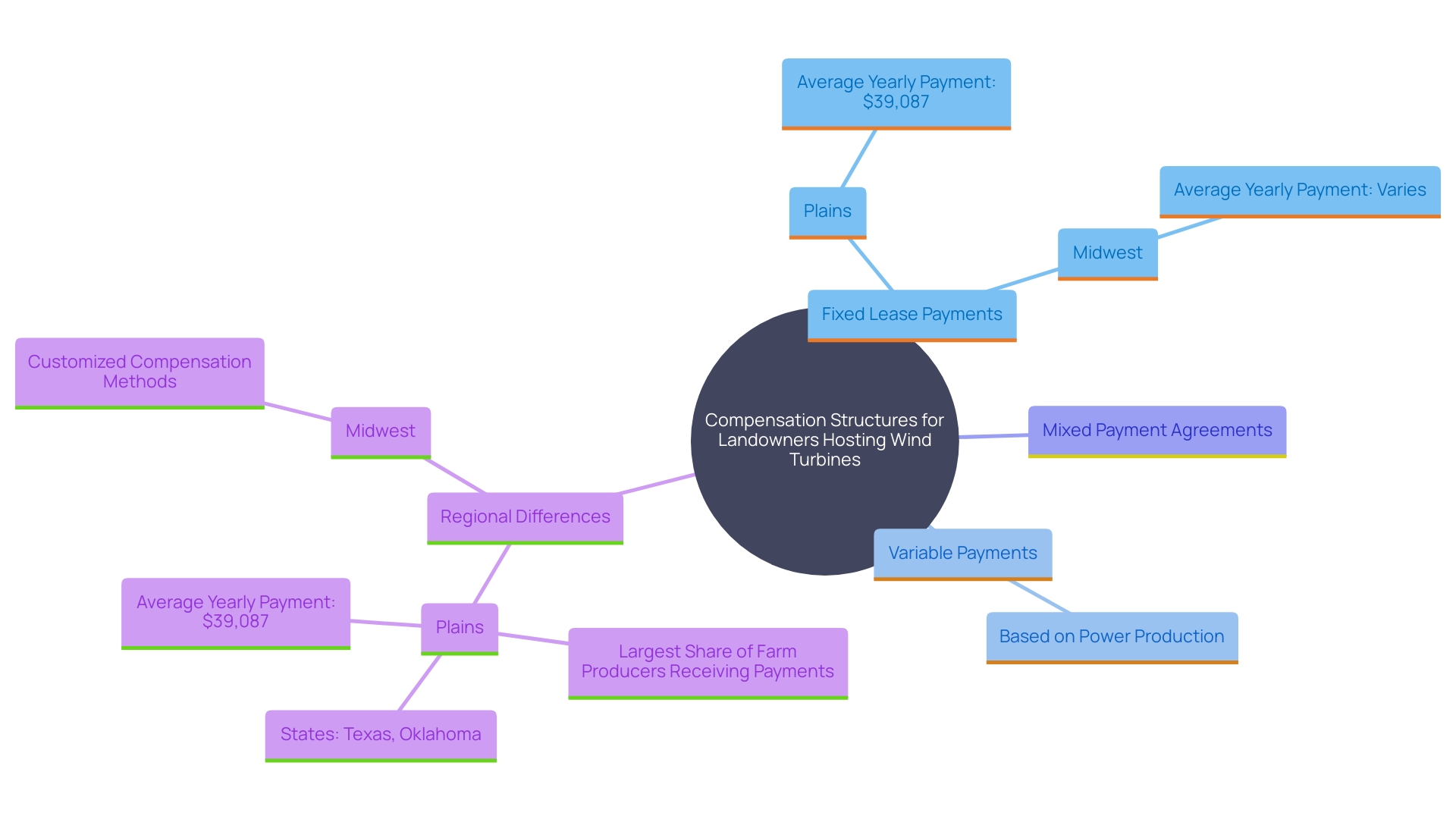
Wind Estate and Legal Considerations
Creating energy farms involves intricate legal agreements to define land ownership and usage rights. Landowners face challenges navigating property rights, zoning laws, and potential easements, which can significantly impact their land. Consulting with legal experts is essential to understand the implications of wind agreements, which often include restrictions on land use and long-term commitments spanning 20 to 30 years. The process can be complex and vary significantly by state, as local governments often have considerable authority over siting and permitting. For instance, in 27 states, the principal siting and permitting authority depends on the scale of the endeavor.
A notable case highlighting these complexities involves the Osage tribe, which stands to collect significant damages and has mandated the removal of turbines due to improper consultation during development stages. This situation illustrates the growing resistance to renewable power initiatives, with 417 denials or limitations in the U.S. since 2015. Furthermore, the recent achievement of the Vineyard Wind initiative, supplying over 800 megawatts of electricity to New England’s grid, highlights the significance of careful planning and adherence to regulations in effectively realizing renewable initiatives.
Understanding the local regulatory landscape is crucial, as no two states are alike in their approach to siting and permitting large-scale renewable energy projects. This variability can make the process challenging for developers and landowners alike, necessitating comprehensive legal and strategic planning to navigate the complexities of land ownership and payments for renewable energy farms.
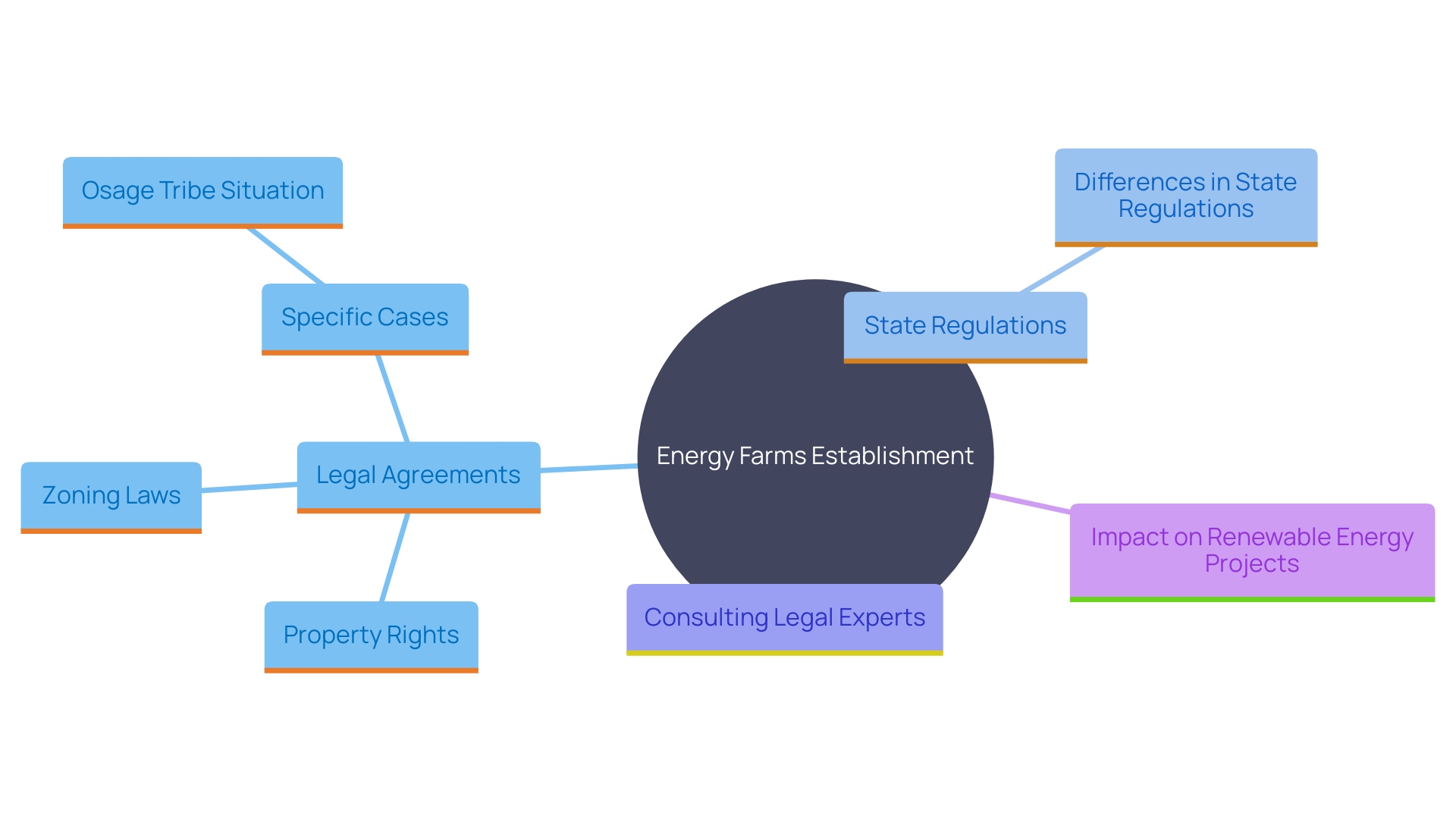
Factors Affecting Wind Royalty Value
Various elements affect the assessment of royalties for landowners, rendering the process complex and ever-changing. The main factors involve the site of the turbine facility, the quality of the local air resource, and prevailing market conditions for power. Regions with stronger and more consistent air currents typically command higher royalty rates, as they are more lucrative for energy production.
Additionally, the proximity to existing transmission infrastructure plays a crucial role. Wind farms located near established transmission lines can reduce costs related to infrastructure development, thereby potentially increasing the compensation levels for landowners. The magnitude of the undertaking also influences compensation, with larger endeavors often offering economies of scale that can lead to higher payouts.
Moreover, the distance to the nearest turbine can have significant economic implications. According to studies, the average distance to the nearest turbine for properties in the United States has decreased from 148.6 miles in 2005 to 37.1 miles in 2020. This proximity can lead to controversy, particularly concerning property values. A significant discovery is that properties within a mile of a proposed energy farm experience an average decline in value of 11 percent after the announcement of the initiative. However, this effect tends to fade a few years after the initiative becomes operational.
Grasping these elements is crucial for landowners when discussing royalties, as they directly affect the financial advantages gained from renting land for renewable power initiatives. By considering the site, air resource quality, initiative size, and proximity to infrastructure, landowners can better assess the potential value of their royalties.
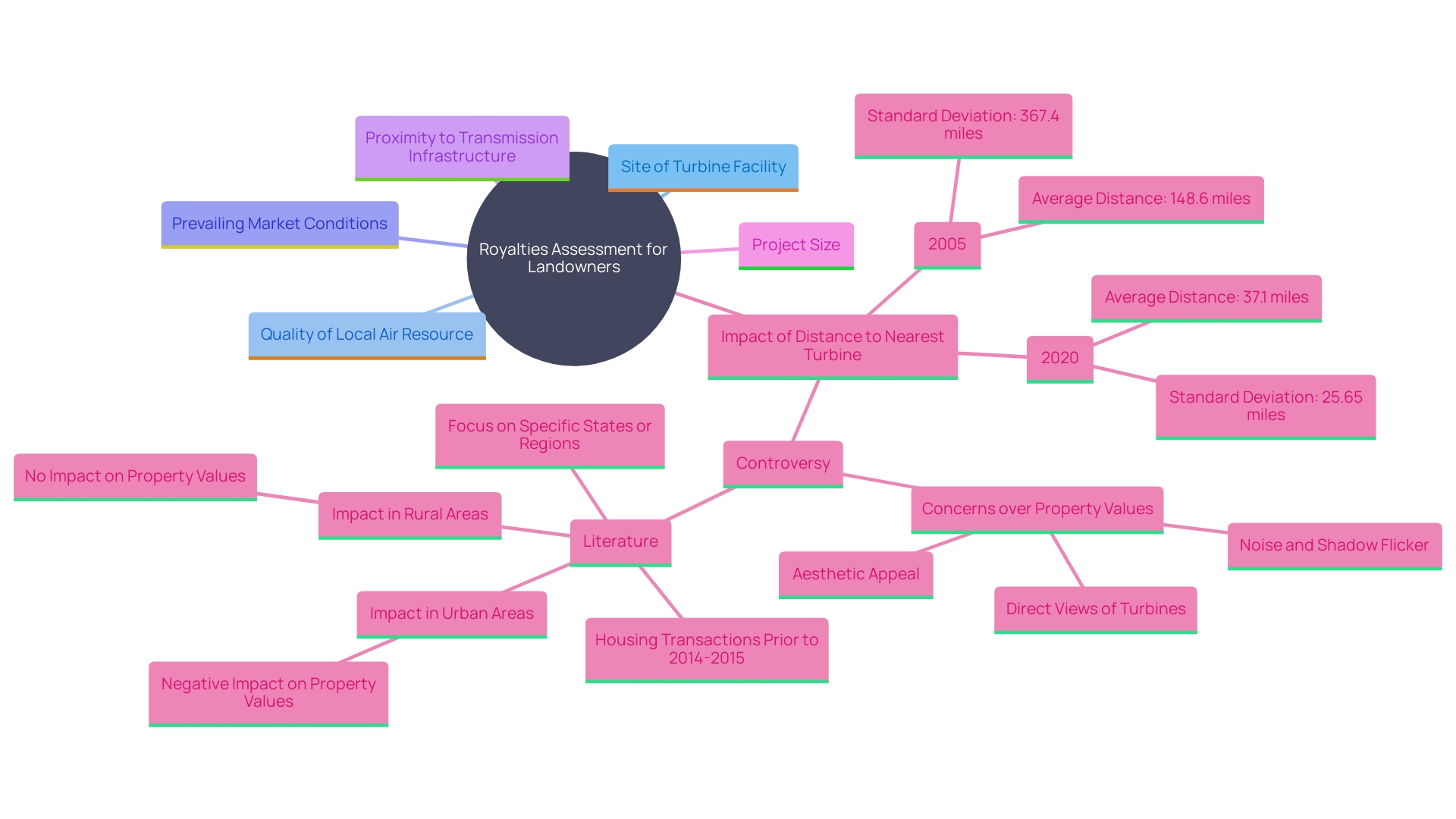
Landowner Payments and Economic Impact
The financial effect of renewable power initiatives on property owners can be significant. Payments from turbine leases introduce a new revenue source that strengthens regional economies, enhances landowner financial stability, and promotes agricultural diversification. These payments often enable landowners to invest in property improvements, upgrade facilities, or sustain family farms during periods of low agricultural income.
Significantly, energy development payments can differ by area, with the Plains region experiencing the highest average yearly payments. For instance, between 2011 and 2020, farmers in this region received an average annual payment of $39,087, significantly higher than those in other regions. This financial support can be crucial for landowners, particularly during challenging economic times.
However, the existence of energy farms can also affect local property values. Research has indicated that residences located within one mile of a turbine farm encounter an average price decrease of approximately 11% following the announcement and throughout the building phase. Interestingly, these prices typically rebound to pre-announcement levels within three to five years of the initiative becoming operational. Residences situated one to two miles from a turbine facility experience significantly reduced effects, and those further than two miles are typically not influenced.
Regardless of these variations in property worth, the overall advantages of renewable power initiatives, such as employment generation, tax income, and ecological sustainability, frequently surpass the short-term economic disturbances. Thus, wind power continues to be a valuable and sustainable economic resource for landowners and their communities.
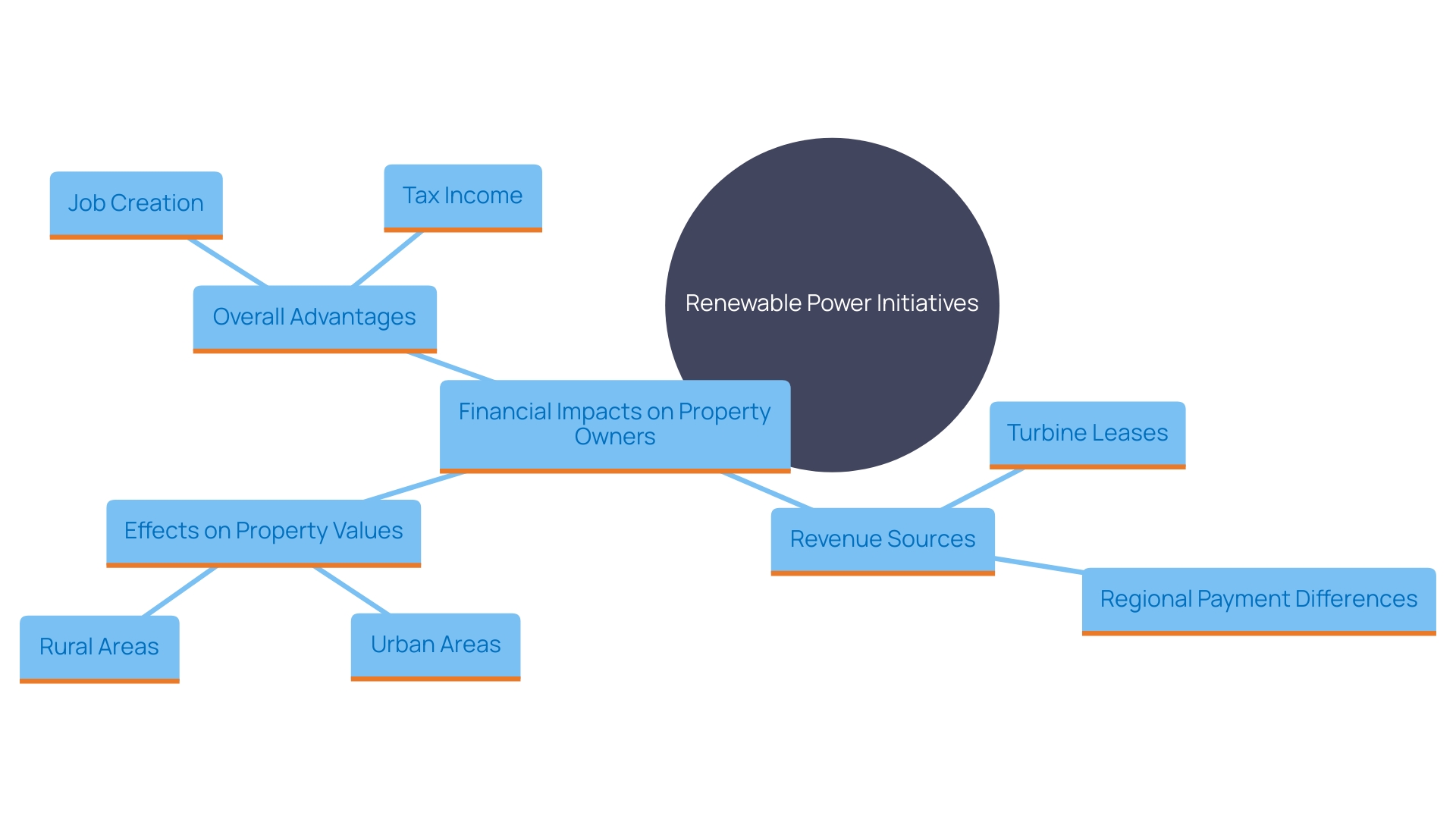
Benefits to Local Communities
'Wind power initiatives offer substantial financial and societal advantages to nearby communities, reaching far beyond the direct compensation to property owners.'. These initiatives have the potential to generate numerous jobs during building and operational phases, thereby boosting regional economies. For instance, the City of Salem, in collaboration with Crowley, has established a Community Benefits Agreement (CBA) worth nearly $9 million, which includes commitments and funding for workforce and economic development. This agreement aims to support infrastructure, jobs, education, and public safety initiatives.
Furthermore, renewable power initiatives produce significant tax income for regional authorities, which can be reinvested into community growth. The Kitty Hawk Wind Initiative in Virginia Beach is an illustration of how such endeavors can generate new tax income and assist in achieving clean energy objectives, as emphasized by Hampton Roads Chamber CEO Bryan Stephens.
Furthermore, numerous energy initiatives create community benefit agreements that specifically designate funds for local programs. These include infrastructure improvements, educational programs, and environmental conservation efforts. For instance, the Salem Offshore Energy Terminal initiative involves $400,000 in scholarships for offshore energy or maritime-related career paths and $187,500 for bilingual outreach and educational programs.
Overall, the incorporation of renewable projects into communities not only aids the shift to sustainable power sources but also delivers extensive economic and social benefits, encouraging lasting community resilience and development.

Decommissioning and Maintenance Responsibilities
Landowners must be acutely aware of the responsibilities tied to the decommissioning of turbines once they reach the end of their operational life. Lease contracts generally specify that energy firms must dismantle turbines and return the land to its initial condition. This process is not only extensive but also involves significant logistical challenges. For instance, in a recent case, the removal of 84 turbines in Pawhuska required obtaining proper permits, expanding nearby roads for transporting equipment, and using explosives for demolition. Such a process can take up to 18 months and involves manual removal of blades and partial excavation of concrete foundations.
Understanding these decommissioning responsibilities is crucial for landowners to avoid unexpected liabilities. As seen in North Carolina, a state policy mandates that owners must prove their financial capability to cover decommissioning costs and restore the site to its previous use. This policy requires filing decommissioning plans and updating them every five years.
Moreover, the intricacy of rules in different states can generate chances for resistance to renewable energy initiatives. Despite this, state and local rules are generally clear that developers or owners are responsible for restoration. This clarity helps ensure that landowners are not burdened with cleanup costs. The growing resistance to renewable energy initiatives, as demonstrated by the Osage tribe's legal success over Enel, further highlights the significance of being well-informed about these responsibilities to protect against possible legal and financial consequences.
Financial Incentives and Community Benefits Agreements
Federal and state authorities frequently offer financial incentives that greatly enhance the economic feasibility of turbine projects. For example, assured rates for electricity produced by turbine farms are a typical motivation, especially vital in areas such as Louisiana, Texas, and Mississippi where such initiatives are limited. These incentives are vital for creating electricity markets that can support a dramatic increase in green energy.
Community benefits agreements (CBAs) often accompany renewable energy projects, ensuring that nearby communities directly benefit from these developments. CBAs can include funding for community schools, infrastructure, and public services, which landowners may negotiate as part of their agreements. This method not only aids the energy farm's success but also promotes regional economic growth and community advancement.
For instance, in the region of Rotenburg in Germany, the building and functioning of energy parks are anticipated to produce 725 million euros for the regional economy and 370 million euros in taxes and fees by 2040. This demonstrates the substantial economic benefits that can be realized through well-negotiated CBAs and supportive government policies.
Moreover, the Community Renewable Energy Generation (CREG) Fund in Prince Edward Island exemplifies how community-driven initiatives can thrive. With a three-year, $3.5 million fund, municipalities and Indigenous communities can promote renewable power initiatives, including wind, which further emphasizes the significance of community participation in renewable efforts.
In Colorado, regional authorities and county commissioners play a crucial role in the siting and permitting of renewable energy initiatives. However, they often face challenges such as limited technical capacity and local opposition. Tackling these issues via state assistance and community involvement can result in more effective implementations and enhanced community advantages.
The growing closeness of energy initiatives to residential zones has ignited discussions regarding their effects. Research indicates that although city-based energy initiatives may adversely impact property values, countryside initiatives generally do not. This highlights the need for careful planning and community involvement to balance the benefits and potential drawbacks of wind energy projects.
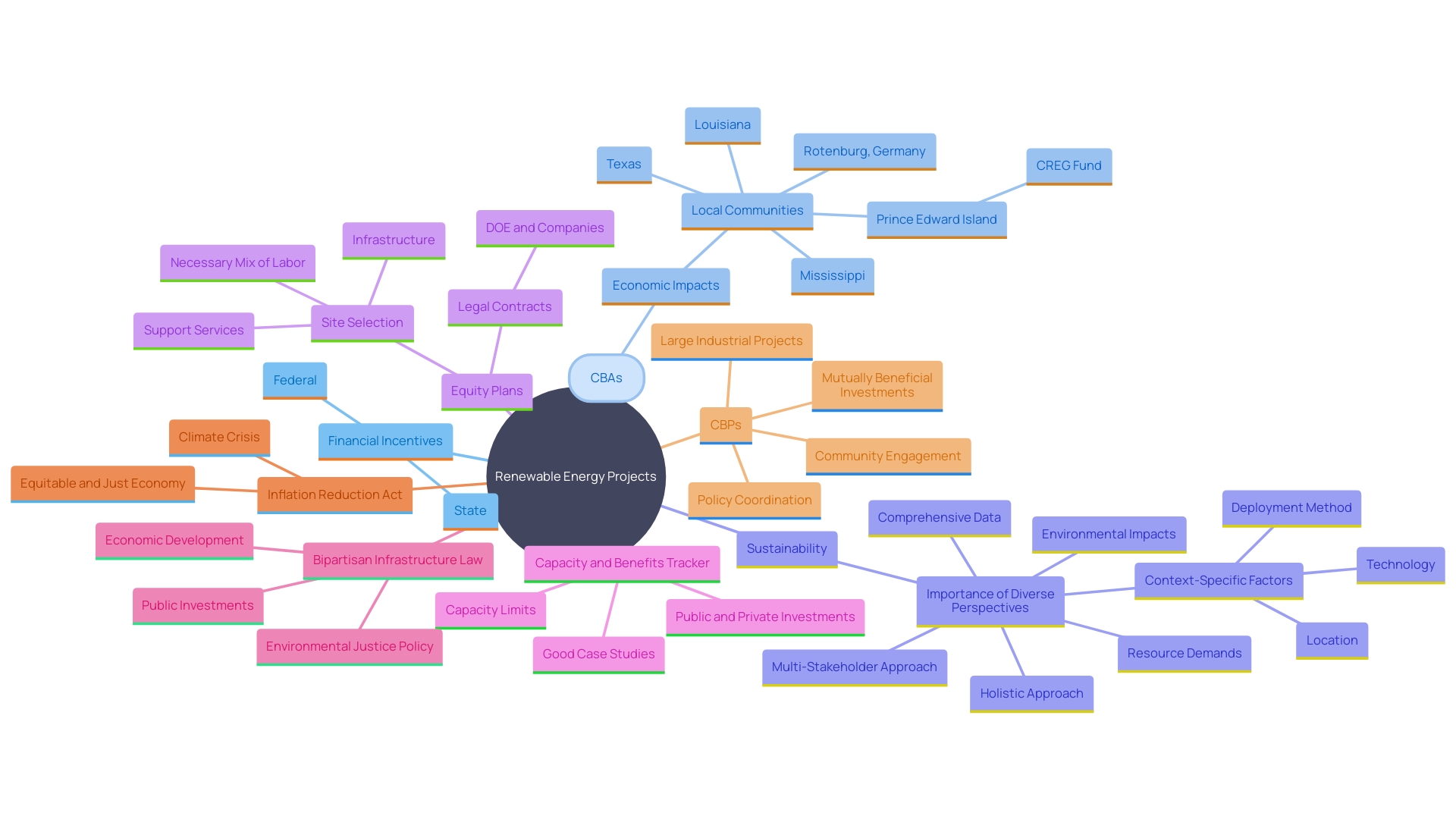
Conclusion
The exploration of wind energy development reveals a multifaceted landscape where landowners, local communities, and regulatory frameworks intersect. Various types of wind royalties and payments provide landowners with financial incentives that can significantly bolster their income, particularly in regions where wind energy projects are prevalent. The differences in payment structures, influenced by location, wind resource quality, and proximity to infrastructure, underscore the need for landowners to thoroughly understand these financial dynamics to maximize their benefits.
Legal considerations play a critical role in establishing wind estates, as landowners must navigate complex property rights, zoning laws, and long-term commitments. The importance of consulting legal experts cannot be overstated, as these professionals can help landowners comprehend the implications of wind agreements and ensure compliance with state-specific regulations. Furthermore, the economic impact of wind energy projects extends beyond individual landowners, fostering job creation, generating tax revenues, and enhancing community development through well-structured community benefits agreements.
Additionally, the responsibilities tied to decommissioning and maintenance of wind turbines must be clearly understood by landowners to avoid unexpected liabilities. The regulatory landscape governing these obligations varies significantly across states, necessitating proactive engagement from landowners to ensure compliance and safeguard their interests. Overall, the integration of wind energy projects into local economies offers substantial opportunities for financial stability and sustainable growth, provided that all parties involved are well-informed and actively engaged in the process.




